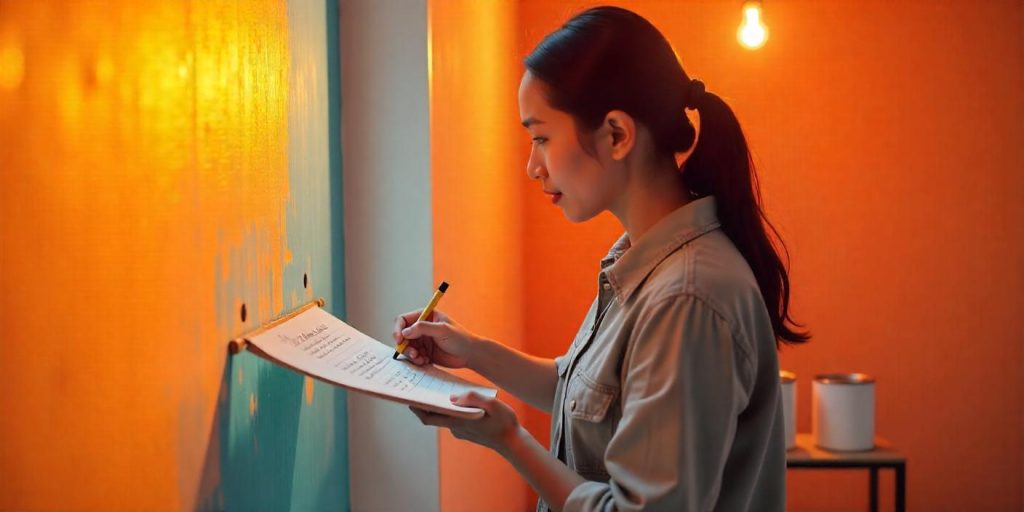Painting a room is a rewarding DIY project, but estimating the right amount of paint is crucial for avoiding waste and ensuring a seamless finish.

This guide explains how to calculate the amount of paint you’ll need, helping you save time, money, and effort.
Contents
Why Accurate Paint Calculation Matters
Reducing Waste
Buying too much paint leads to waste, both environmentally and financially.
Avoiding Shortages
Running out of paint midway can disrupt the project and cause inconsistencies in color.
Cost Efficiency
Proper calculations help you stick to your budget and avoid unnecessary purchases.
Tools You’ll Need for Accurate Calculations
Measuring Tools
- Measuring tape
- Pencil and paper for notes
Calculator
- Use a standard calculator or a smartphone app.
Optional: Paint Estimator Tool
- Many paint brands offer online calculators to simplify the process.
Steps to Calculate Paint for a Room
Step 1: Measure Wall Dimensions
- Measure the width of each wall in feet or meters.
- Measure the height from floor to ceiling.
- Multiply the width and height of each wall to find the area.
Example Calculation
- Wall 1: Width = 12 feet, Height = 10 feet → 12 x 10 = 120 square feet
- Wall 2: Width = 10 feet, Height = 10 feet → 10 x 10 = 100 square feet
- Total Wall Area = 120 + 100 + 120 + 100 = 440 square feet
Step 2: Subtract Non-Paintable Areas
- Measure doors, windows, and other non-paintable features.
- Subtract their area from the total wall area.
Example
- Door Area: 7 feet x 3 feet = 21 square feet
- Window Area: 5 feet x 3 feet = 15 square feet
- Non-Paintable Area = 21 + 15 = 36 square feet
- Paintable Area = 440 – 36 = 404 square feet
Step 3: Determine Paint Coverage
- Check the paint can for coverage details, typically measured in square feet per gallon or liter.
- Standard coverage: One gallon covers approximately 350–400 square feet.
Example
- If the paintable area is 404 square feet and one gallon covers 350 square feet, you’ll need 1.2 gallons of paint.
Step 4: Account for Coats of Paint
- Multiply the paintable area by the number of coats required.
- Most projects require two coats for even coverage.
Example
- Paintable Area = 404 square feet
- Two Coats = 404 x 2 = 808 square feet
- Paint Needed = 808 ÷ 350 = 2.3 gallons (round up to 3 gallons)
Factors That Affect Paint Calculations
Type of Paint
- Matte and flat paints may require more coats than gloss or satin finishes.
Wall Texture
- Textured surfaces like stucco or brick absorb more paint than smooth walls.
Primer Usage
- Using a primer can reduce the amount of paint needed, especially on porous surfaces.
Color Changes
- Dark-to-light or light-to-dark transitions may require additional coats for complete coverage.
Tips for Optimizing Paint Usage
Use a Primer
- Apply a primer first to improve paint adhesion and coverage.
Invest in Quality Paint
- Higher-quality paints often provide better coverage, reducing the need for multiple coats.
Plan for Touch-Ups
- Keep a small amount of paint for future touch-ups.
Stir Paint Thoroughly
- Mixing paint ensures consistent color and texture.
Using Online Paint Calculators
Benefits
- Quick and easy estimations.
- Adjust for variables like texture and primer.
Popular Tools
- Sherwin-Williams Paint Calculator
- Benjamin Moore Paint Calculator
- Home Depot Project Estimator
Additional Considerations
Ceilings
- Measure ceiling dimensions separately if they need painting.
Example
- Ceiling Length = 12 feet, Width = 10 feet → 12 x 10 = 120 square feet
- Total Ceiling Paint Needed: 120 ÷ 350 = 0.34 gallons (round up to 1 gallon for two coats).
Trim and Baseboards
- Measure trim and baseboards separately, using smaller paint cans for these areas.
Example
- Trim Length = 40 feet, Height = 4 inches → (40 x 0.33) = 13.2 square feet
FAQs About Paint Calculation
Can I reuse leftover paint from previous projects?
- Yes, but ensure the color matches and the paint is still in good condition.
What if my calculations are slightly off?
- It’s better to overestimate slightly to avoid shortages. Most stores allow returns of unopened cans.
Should I include extra paint for future touch-ups?
- Yes, keeping an extra quart or small container ensures consistency for touch-ups.
Conclusion
Accurately calculating the amount of paint for your room ensures a smooth and cost-effective project.
By following these steps and considering factors like wall texture and primer, you’ll achieve professional results without the guesswork. With a little preparation, your room transformation can be both satisfying and stress-free.
